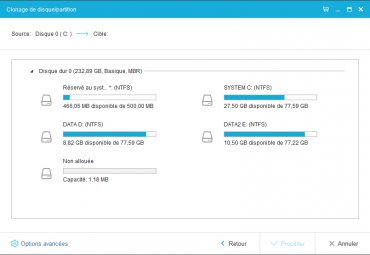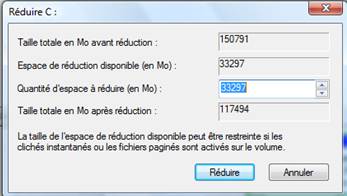Il existe diverses façons de créer une clé usb avec une version réduite de windows xp
nous allons voir ici la manière d’y mettre la version complète
tout d’abord copiez le contenu de votre CD XP dans un répertoire
que vous aurez créé
par exemple [b]C:\USB-XP[/b]
créez un autre répertoire par exemple [b]C:\CAB SDK [/b]
et y mettre ceci :
[b]=>[/b] [url= »http://www.pcinpact.com/link.php?url=http%3A%2F%2Fdownload.microsoft.com%2Fdownload%2Fplatformsdk%2Fcab%2F2.0%2Fw98nt42kmexp%2Fen-us%2FCabsdk.exe »]CAB SDK de Microsoft[/url]
[u]copiez les fichiers qui se trouvent dans
[b]C:\USB-XP[/b] dans le répertoire de [b]C:\CAB SDK [/b]:[/u]
[b]TXTSETUP.SIF
DOSNET.INF
USB.IN_
USBPORT.IN_
USBSTOR.IN_[/b]
il suffit maintenant simplement de les modifier
ouvrez le bloc-notes, copiez y ceci :
[b]cabarc x USB.IN_
cabarc x USBPOR.IN_
cabarc x USBSTOR.IN_[/b]
enregistrez le dans le répertoire cabSDK\BIN et nommez le [b]zip.bat[/b]
ensuite clic droit sur [b]zip.bat[/b]
pour modifier ces fichiers en .INF
maintenant Editer le fichier [b]TXTSETUP.SIF [/b]
(avec le bloc-notes)
Déplacez les lignes en gras de [i]InputDevicesSupport.Load[/i] vers la section [i]BootBusExtenders.Load[/i]
[u]BootBusExtenders.Load[/u]
pci = pci.sys
acpi = acpi.sys
isapnp = isapnp.sys
acpiec = acpiec.sys
ohci1394 = ohci1394.sys
[u]InputDevicesSupport.Load[/u]
[b]usbehci = usbehci.sys [/b]
[b]usbohci = usbohci.sys
usbuhci = usbuhci.sys
usbhub = usbhub.sys [/b]
usbccgp = usbccgp.sys
hidusb = hidusb.sys
serial = serial.sys
serenum = serenum.sys
[b]usbstor = usbstor.sys [/b]
même chose pour [i]BootBusExtenders[/i] et
[i]InputDevicesSupport[/i]
[u]BootBusExtenders[/u]
pci = « PCI-Bustreiber »,files.pci,pci
acpi = « ACPI Plug & Play-Bustreiber »,files.acpi,acpi
isapnp = « ISA Plug & Play-Bustreiber »,files.isapnp,isapnp
acpiec = « Integrierter ACPI-Controllertreiber »,files.none,acpiec
ohci1394 = « IEEE-1394-Bus-OHCI-konformer Anschlusstreiber »,files.ohci1394,ohci1394
[u]InputDevicesSupport[/u]
[b]usbehci = « Erweiterter Hostcontroller »,files.usbehci,usbehci
usbohci = « Open Hostcontroller »,files.usbohci,usbohci
usbuhci = « Universeller Hostcontroller »,files.usbuhci,usbuhci
usbhub = « Standard-USB-Hubtreiber »,files.usbhub,usbhub [/b]
hidusb = « HID-Parser »,files.hidusb,hidusb
serial = « Treiber fr seriellen Anschluss »,files.none,serial
serenum = « Enumerator fr seriellen Anschluss »,files.none,serenum
[b]usbstor = « USB-Speicherklassentreiber »,files.usbstor,usbstor [/b]
usbccgp = « USB Generic Parent Driver »,files.usbccgp,usbccgp
ensuite il faut simplement [u]modifier[/u] les lignes en gras dans les sections suivantes comme ceci :
[u]HiveInfs.Fresh[/u]
AddReg = hivedef.inf,AddReg
AddReg = hivesys.inf,AddReg
AddReg = hivesft.inf,AddReg
AddReg = hivecls.inf,AddReg
AddReg = hiveusd.inf,AddReg
AddReg = dmreg.inf,DM.AddReg
[b]AddReg = usbboot.inf,usbservices [/b]
et dans [u]SourceDisksFiles[/u]
[b]usbboot.inf = 1,,,,,,_x,3,,3 [/b]
bootvid.dll = 1,,,,,,3_,2,0,0,,1,2
kdcom.dll = 1,,,,,,3_,2,0,0,,1,2
enregistrez les modifications du fichier [b]TXTSETUP.SIF[/b]
maintenant modifiez le fichier [b]DOSNET.INF[/b] comme ceci :
[u]Files[/u]
[b]d1,usbboot.inf [/b]
d1,_default.pif
d1,12520437.cpx
d1,12520850.cpx
enregistrez les modifications
au tour du fichier [b]usb.inf[/b] comme ceci :
les lignes en gras dans [i]StandardHub.AddService[/i] et [i]CommonClassParent.AddService[/i]
[u]StandardHub.AddService[/u]
DisplayName = %StandardHub.SvcDesc%
ServiceType = 1 ; SERVICE_KERNEL_DRIVER
[b]StartType = 0 ; SERVICE_DEMAND_START [/b]
ErrorControl = 1 ; SERVICE_ERROR_NORMAL
ServiceBinary = %12%\usbhub.sys
[b]LoadOrderGroup = Boot Bus Extender [/b]
[u]CommonClassParent.AddService[/u]
DisplayName = %GenericParent.SvcDesc%
ServiceType = 1 ; SERVICE_KERNEL_DRIVER
[b]StartType = 0 ; SERVICE_DEMAND_START [/b]
ErrorControl = 1 ; SERVICE_ERROR_NORMAL
ServiceBinary = %12%\usbccgp.sys
[b]LoadOrderGroup = Boot Bus Extender [/b]
enregistrez les modifications
pareil pour le fichier [b]usbport.inf[/b]
[u]EHCI.AddService[/u]
DisplayName = %EHCIMP.SvcDesc%
ServiceType = 1 ; SERVICE_KERNEL_DRIVER
[b]StartType = 0[/b] ; SERVICE_DEMAND_START
ErrorControl = 1 ; SERVICE_ERROR_NORMAL
ServiceBinary = %12%\usbehci.sys
[b]LoadOrderGroup = Boot Bus Extender [/b]
[u]OHCI.AddService[/u]
DisplayName = %OHCIMP.SvcDesc%
ServiceType = 1 ; SERVICE_KERNEL_DRIVER
[b]StartType = 0[/b] ; SERVICE_DEMAND_START
ErrorControl = 1 ; SERVICE_ERROR_NORMAL
ServiceBinary = %12%\usbohci.sys
[b]LoadOrderGroup = Boot Bus Extender [/b]
[u]UHCI.AddService[/u]
DisplayName = %UHCIMP.SvcDesc%
ServiceType = 1 ; SERVICE_KERNEL_DRIVER
[b]StartType = 0[/b] ; SERVICE_DEMAND_START
ErrorControl = 1 ; SERVICE_ERROR_NORMAL
ServiceBinary = %12%\usbuhci.sys
[b]LoadOrderGroup = Boot Bus Extender[/b]
[u]ROOTHUB.AddService[/u]
DisplayName = %ROOTHUB.SvcDesc%
ServiceType = 1 ; SERVICE_KERNEL_DRIVER
[b]StartType = 0 [/b]; SERVICE_DEMAND_START
ErrorControl = 1 ; SERVICE_ERROR_NORMAL
ServiceBinary = %12%\usbhub.sys
[b]LoadOrderGroup = Boot Bus Extender [/b]
enregistrez les modifications
et pour le fichier [b]usbstor.inf[/b]
[u]USBSTOR.AddService[/u]
DisplayName = %USBSTOR.SvcDesc%
ServiceType = 1
[b]StartType = 0
Tag = 3 [/b]
ErrorControl = 1
ServiceBinary = %12%\USBSTOR.SYS
[b]LoadOrderGroup = Boot Bus Extender [/b]
enregistrez les modifications
créez ensuite un nouveau fichier avec le bloc-notes
et copiez/collez y ceci :
[code][usbservices]
HKLM, »SYSTEM\CurrentControlSet\Services\USBSTOR », »DisplayName »,0x00000000, »USB Mass Storage Driver »
HKLM, »SYSTEM\CurrentControlSet\Services\USBSTOR », »ErrorControl »,0x00010001,1
HKLM, »SYSTEM\CurrentControlSet\Services\USBSTOR », »Group »,0x00000000, »System Reserved »
HKLM, »SYSTEM\CurrentControlSet\Services\USBSTOR », »ImagePath »,0x00020000, »system32\DRIVERS\USBSTOR.SYS »
HKLM, »SYSTEM\CurrentControlSet\Services\USBSTOR », »Start »,0x00010001,0
HKLM, »SYSTEM\CurrentControlSet\Services\USBSTOR », »Type »,0x00010001,1
HKLM, »SYSTEM\CurrentControlSet\Services\usbehci », »DisplayName »,0x00000000, »USB 2.0 Enhanced Host Controller Miniport Driver »
HKLM, »SYSTEM\CurrentControlSet\Services\usbehci », »ErrorControl »,0x00010001,1
HKLM, »SYSTEM\CurrentControlSet\Services\usbehci », »Group »,0x00000000, »System Reserved »
HKLM, »SYSTEM\CurrentControlSet\Services\usbehci », »ImagePath »,0x00020000, »system32\DRIVERS\usbehci.sys »
HKLM, »SYSTEM\CurrentControlSet\Services\usbehci », »Start »,0x00010001,0
HKLM, »SYSTEM\CurrentControlSet\Services\usbehci », »Type »,0x00010001,1
HKLM, »SYSTEM\CurrentControlSet\Services\usbhub », »DisplayName »,0x00000000, »USB2 Enabled Hub »
HKLM, »SYSTEM\CurrentControlSet\Services\usbhub », »ErrorControl »,0x00010001,1
HKLM, »SYSTEM\CurrentControlSet\Services\usbhub », »Group »,0x00000000, »System Reserved »
HKLM, »SYSTEM\CurrentControlSet\Services\usbhub », »ImagePath »,0x00020000, »system32\DRIVERS\usbhub.sys »
HKLM, »SYSTEM\CurrentControlSet\Services\usbhub », »Start »,0x00010001,0
HKLM, »SYSTEM\CurrentControlSet\Services\usbhub », »Type »,0x00010001,1
HKLM, »SYSTEM\CurrentControlSet\Services\usbuhci », »DisplayName »,0x00000000, »Microsoft USB Universal Host Controller Miniport Driver »
HKLM, »SYSTEM\CurrentControlSet\Services\usbuhci », »ErrorControl »,0x00010001,1
HKLM, »SYSTEM\CurrentControlSet\Services\usbuhci », »Group »,0x00000000, »System Reserved »
HKLM, »SYSTEM\CurrentControlSet\Services\usbuhci », »ImagePath »,0x00020000, »system32\DRIVERS\usbuhci.sys »
HKLM, »SYSTEM\CurrentControlSet\Services\usbuhci », »Start »,0x00010001,0
HKLM, »SYSTEM\CurrentControlSet\Services\usbuhci », »Type »,0x00010001,1
HKLM, »SYSTEM\CurrentControlSet\Services\usbohci », »DisplayName »,0x00000000, »Microsoft USB Open Host Controller Miniport Driver »
HKLM, »SYSTEM\CurrentControlSet\Services\usbohci », »ErrorControl »,0x00010001,1
HKLM, »SYSTEM\CurrentControlSet\Services\usbohci », »Group »,0x00000000, »System Reserved »
HKLM, »SYSTEM\CurrentControlSet\Services\usbohci », »ImagePath »,0x00020000, »system32\DRIVERS\usbohci.sys »
HKLM, »SYSTEM\CurrentControlSet\Services\usbohci », »Start »,0x00010001,0
HKLM, »SYSTEM\CurrentControlSet\Services\usbohci », »Type »,0x00010001,1[/code]
enregistrez le et nommez le [b]=>[/b] [b]USBBOOT.INF [/b]
créez un autre fichier, nommez le [b]=>[/b] [b]compresser.bat[/b] dans le répertoire [b]cabSDK[/b]
en y copiant ceci :
[b]cabarc n USB.IN_ usb.inf
cabarc n USBPORT.IN_ usbport.inf
cabarc n USBSTOR.IN_ usbstor.inf [/b]
clic droit dessus et exécuter pour les modifications
pour finir copiez tous les fichiers que vous avez modifié
c’est à dire ceux la :
[b]TXTSETUP.SIF
DOSNET.INF
USB.IN_
USBPORT.IN_
USBSTOR.IN_
USBBOOT.INF[/b]
directement dans le repertoire [b]=> C:\USB-XP[/b]
il vous suffira ensuite simplement de créer une image ISO
de ce répertoire avec ceci par exemple [b]=>[/b][url= »http://winfuture.de/xpisobuilder3_en »] xpisobuilder[/url]
et de graver ensuite l’image avec un logiciel de gravure
[u]pour l’installation de l’ISO sur la clé USB :[/u]
débranchez tous les périphériques (tous les dd internes également)
ensuite mettez USB en 1er boot dans le bios et en 2eme le CDROM
connectez la clé en direct sans hub sur le port usb
redémarrez le pc et lancez l’installation d’xp sur la clé
[i](formatage NTFS)[/i]
[b]=>[/b] [url= »http://www.ngine.de/index.jsp?pageid=4176″]source[/url]
[i](en anglais)[/i]
si vous avez une question direction, direction le [url=http://forum.tplpc.com/index.php?showtopic=13311]forum[/url]


